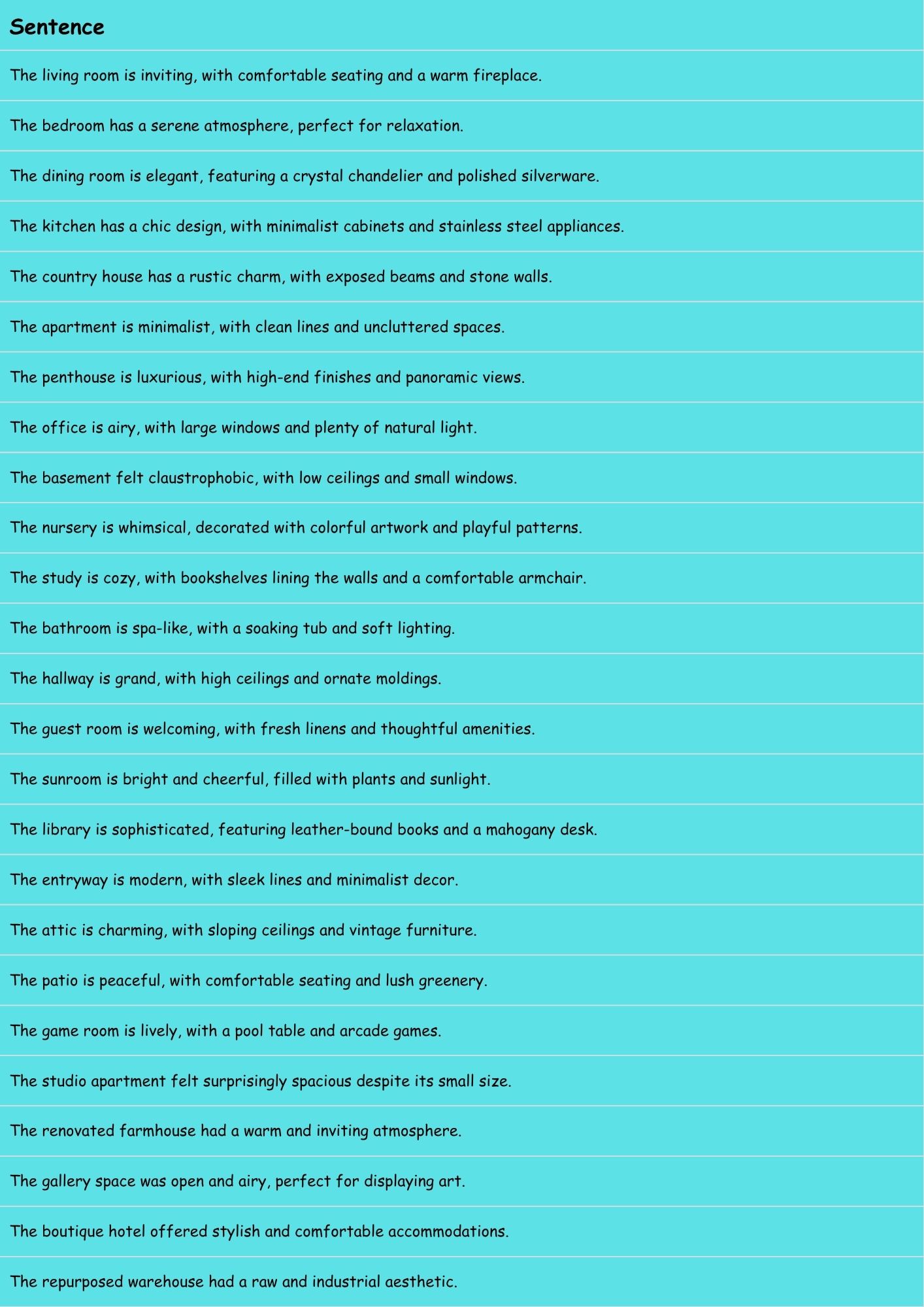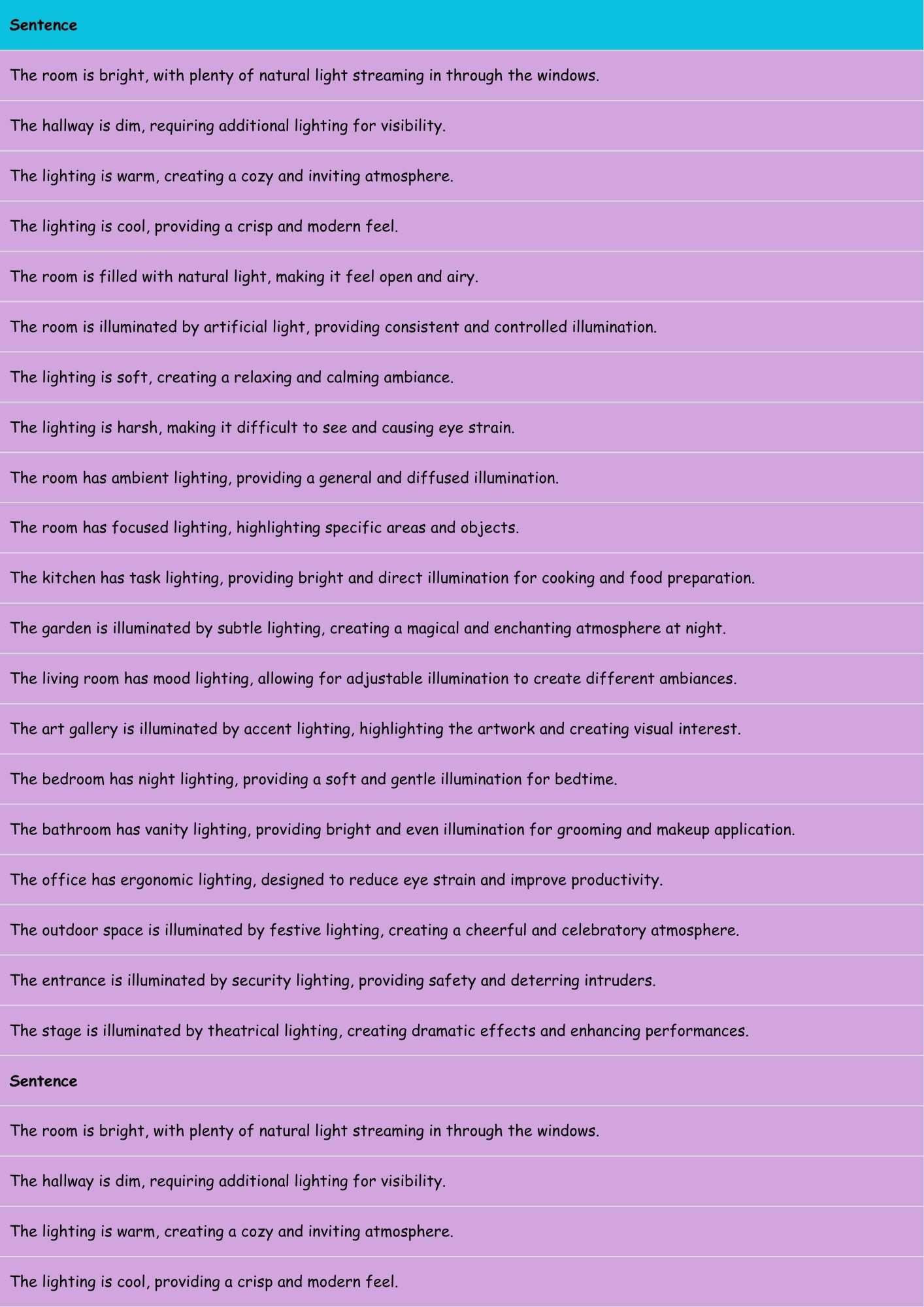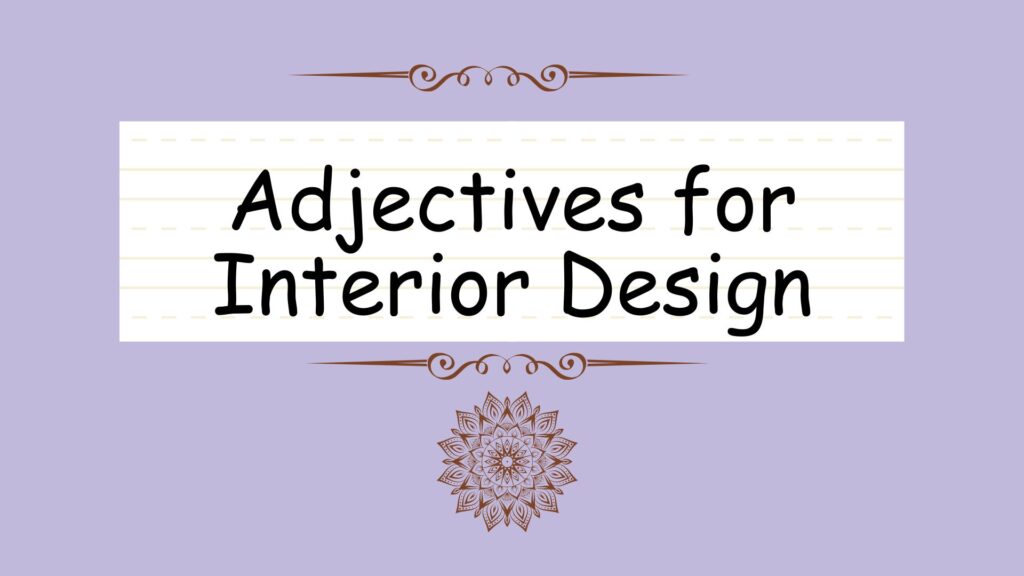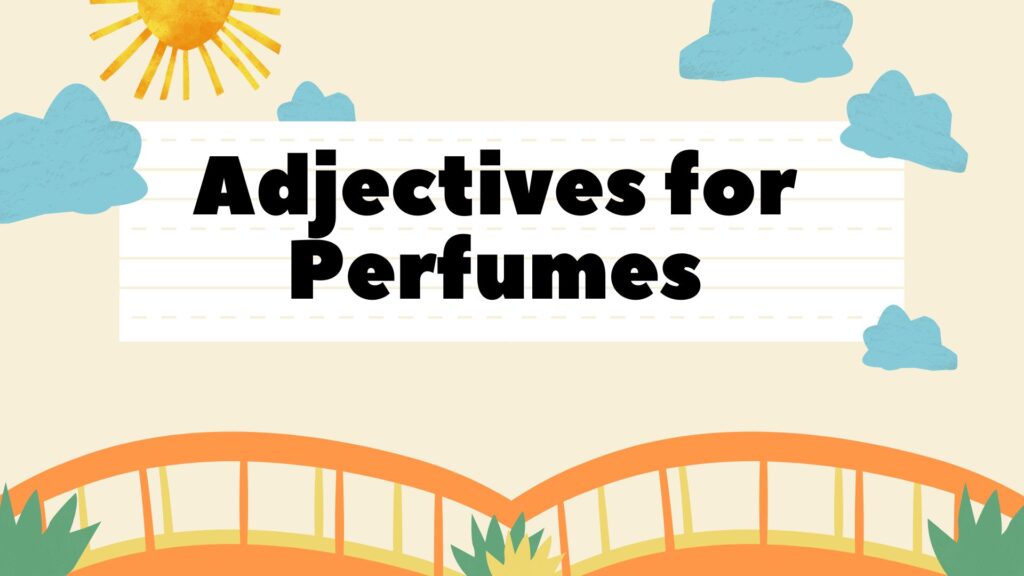Mastering the use of adjectives is essential for anyone looking to describe interior spaces effectively, whether you’re an interior designer, a real estate agent, or simply someone who enjoys discussing home decor. This article provides a comprehensive guide to using descriptive adjectives in the context of interior design, covering definitions, types, usage rules, common mistakes, and practice exercises. Understanding how to use these adjectives correctly will allow you to vividly communicate the style, ambiance, and features of any interior space, making your descriptions more engaging and informative.
Table of Contents
- Introduction
- Definition of Adjectives for Interiors
- Structural Breakdown
- Types of Adjectives for Interiors
- Examples of Adjectives in Interior Design
- Usage Rules for Adjectives in Interior Design
- Common Mistakes with Adjectives
- Practice Exercises
- Advanced Topics
- Frequently Asked Questions
- Conclusion
Definition of Adjectives for Interiors
Adjectives are words that describe or modify nouns, providing additional information about their qualities or characteristics. In the context of interior design, adjectives are used to paint a vivid picture of a space, highlighting its features, style, and overall ambiance. They help convey the aesthetic and functional aspects of a room, allowing readers or listeners to visualize the space more clearly. These adjectives can describe color, size, shape, texture, style, material, condition, and lighting, among other attributes.
The function of adjectives in interior design is to enhance communication and create a shared understanding of the space being described. By using precise and descriptive adjectives, one can effectively convey the unique characteristics of a room, influencing the perception and emotional response of the audience. For example, instead of simply saying “the room is nice,” you might say “the room is a spacious and bright living room with plush velvet sofas and gleaming hardwood floors.” This level of detail provides a much richer and more engaging description.
Structural Breakdown
Adjectives typically precede the nouns they modify. However, they can also follow linking verbs such as “is,” “are,” “was,” “were,” “seems,” and “appears.” The placement of adjectives can affect the emphasis of the description. When an adjective precedes a noun, it directly modifies that noun. When it follows a linking verb, it serves as a subject complement, describing the subject of the sentence.
Consider these examples:
- Adjective before noun: The modern kitchen is equipped with stainless steel appliances.
- Adjective after linking verb: The kitchen is modern, with sleek lines and minimalist design.
In both cases, the adjective “modern” describes the kitchen, but the sentence structure differs. The first example emphasizes the “modern kitchen” as a single unit, while the second example describes the kitchen as being in a state of “modernity.” Understanding these structural nuances allows for more precise and effective communication.
Adjectives can also be combined to provide even more detailed descriptions. When using multiple adjectives, it’s important to follow the correct order, which generally follows the sequence: quantity, opinion, size, age, shape, color, origin, material, and purpose. For example, “a beautiful large antique round wooden dining table.”
Types of Adjectives for Interiors
Adjectives used to describe interiors can be categorized based on the specific aspects they highlight. Here are some key categories:
Descriptive Adjectives
Descriptive adjectives are general terms that convey overall impressions and feelings about a space. They can describe the ambiance, atmosphere, or general characteristics of a room.
Examples include:
- Inviting
- Cozy
- Serene
- Elegant
- Chic
- Rustic
- Minimalist
- Luxurious
- Airy
- Claustrophobic
Color Adjectives
Color adjectives specify the colors present in the interior, including walls, furniture, and decor. They can also describe the intensity and tone of the colors.
Examples include:
- Creamy
- Azure
- Emerald
- Scarlet
- Beige
- Lavender
- Charcoal
- Golden
- Silver
- Terracotta
Size and Shape Adjectives
These adjectives describe the dimensions and form of the space and its components, such as furniture and architectural elements.
Examples include:
- Spacious
- Compact
- Tall
- Narrow
- Wide
- Square
- Rectangular
- Circular
- High-ceilinged
- Low-ceilinged
Texture Adjectives
Texture adjectives describe the tactile qualities of surfaces and materials, adding depth to the description.
Examples include:
- Smooth
- Rough
- Soft
- Hard
- Glossy
- Matte
- Velvety
- Sleek
- Bumpy
- Grainy
Style Adjectives
Style adjectives identify the design style or aesthetic of the interior, helping to categorize and understand its overall look.
Examples include:
- Modern
- Traditional
- Contemporary
- Bohemian
- Industrial
- Scandinavian
- Victorian
- Art Deco
- Mid-Century Modern
- Eclectic
Material Adjectives
Material adjectives specify the materials used in the construction and decoration of the interior, providing information about its quality and durability.
Examples include:
- Wooden
- Steel
- Glass
- Brick
- Concrete
- Marble
- Granite
- Ceramic
- Leather
- Fabric
Condition Adjectives
Condition adjectives describe the state of repair or maintenance of the interior, indicating its age and upkeep.
Examples include:
- New
- Old
- Renovated
- Well-maintained
- Dilapidated
- Refurbished
- Pristine
- Worn
- Restored
- Updated
Light Adjectives
Light adjectives describe the quality and intensity of light in the interior, influencing its mood and visibility.
Examples include:
- Bright
- Dim
- Warm
- Cool
- Natural
- Artificial
- Soft
- Harsh
- Ambient
- Focused
Examples of Adjectives in Interior Design
The following tables provide numerous examples of how these adjectives can be used in sentences to describe various aspects of interior design. Each table focuses on a different category of adjectives, providing a range of examples to illustrate their usage.
Table 1: Descriptive Adjectives in Sentences
This table showcases how descriptive adjectives can be used to paint a picture of different interior spaces, highlighting their overall feel and characteristics.
| Sentence |
|---|
| The living room is inviting, with comfortable seating and a warm fireplace. |
| The bedroom has a serene atmosphere, perfect for relaxation. |
| The dining room is elegant, featuring a crystal chandelier and polished silverware. |
| The kitchen has a chic design, with minimalist cabinets and stainless steel appliances. |
| The country house has a rustic charm, with exposed beams and stone walls. |
| The apartment is minimalist, with clean lines and uncluttered spaces. |
| The penthouse is luxurious, with high-end finishes and panoramic views. |
| The office is airy, with large windows and plenty of natural light. |
| The basement felt claustrophobic, with low ceilings and small windows. |
| The nursery is whimsical, decorated with colorful artwork and playful patterns. |
| The study is cozy, with bookshelves lining the walls and a comfortable armchair. |
| The bathroom is spa-like, with a soaking tub and soft lighting. |
| The hallway is grand, with high ceilings and ornate moldings. |
| The guest room is welcoming, with fresh linens and thoughtful amenities. |
| The sunroom is bright and cheerful, filled with plants and sunlight. |
| The library is sophisticated, featuring leather-bound books and a mahogany desk. |
| The entryway is modern, with sleek lines and minimalist decor. |
| The attic is charming, with sloping ceilings and vintage furniture. |
| The patio is peaceful, with comfortable seating and lush greenery. |
| The game room is lively, with a pool table and arcade games. |
| The studio apartment felt surprisingly spacious despite its small size. |
| The renovated farmhouse had a warm and inviting atmosphere. |
| The gallery space was open and airy, perfect for displaying art. |
| The boutique hotel offered stylish and comfortable accommodations. |
| The repurposed warehouse had a raw and industrial aesthetic. |

Table 2: Color and Material Adjectives in Sentences
This table combines color and material adjectives to provide detailed descriptions of the elements within an interior space, such as furniture, walls, and flooring.
| Sentence |
|---|
| The walls are painted a creamy white, creating a soft and inviting ambiance. |
| The sofa is upholstered in azure velvet, adding a touch of luxury to the living room. |
| The curtains are made of emerald silk, filtering the light beautifully. |
| The rug is a scarlet Persian, adding warmth and character to the room. |
| The cabinets are made of wooden oak, providing a natural and sturdy feel. |
| The countertops are marble, offering a sleek and elegant surface. |
| The floor is made of granite tiles, creating a durable and stylish foundation. |
| The chairs are made of steel, giving them a modern and industrial look. |
| The lamps are made of glass, providing a soft and diffused light. |
| The walls are painted a beige color, creating a neutral and calming atmosphere. |
| The accent pillows are lavender, adding a pop of color to the sofa. |
| The fireplace is made of brick, providing a rustic and cozy focal point. |
| The coffee table is charcoal, adding a modern touch to the living room. |
| The picture frames are golden, complementing the artwork on the walls. |
| The silverware is silver, adding a touch of elegance to the dining table. |
| The pots are terracotta, adding a natural and earthy element to the garden. |
| The backsplash is made of ceramic tiles, providing a durable and easy-to-clean surface. |
| The chairs are upholstered in leather, offering a comfortable and luxurious seating option. |
| The drapes are made of fabric, providing privacy and blocking out light. |
| The walls are painted a pale blue, creating a calming and airy atmosphere. |
| The headboard is made of wrought iron, adding a touch of vintage charm. |
| The dining table is a dark mahogany, providing a sophisticated and elegant surface. |
| The cushions are made of linen, offering a comfortable and breathable seating option. |
| The lampshade is made of parchment, diffusing the light softly. |
Table 3: Size, Shape, and Texture Adjectives in Sentences
This table focuses on adjectives that describe the physical dimensions, forms, and tactile qualities of interior elements, adding depth and detail to the descriptions.
| Sentence |
|---|
| The living room is spacious, providing plenty of room for entertaining guests. |
| The apartment is compact, perfect for city living. |
| The ceilings are tall, creating a sense of grandeur and openness. |
| The hallway is narrow, leading to the bedrooms. |
| The windows are wide, allowing plenty of natural light to enter the room. |
| The table is square, providing a functional and stylish surface. |
| The room is rectangular, making it easy to arrange furniture. |
| The mirror is circular, adding a decorative touch to the wall. |
| The building is high-ceilinged, creating a sense of spaciousness. |
| The basement is low-ceilinged, making it feel cozy and intimate. |
| The countertop is smooth, providing a sleek and easy-to-clean surface. |
| The walls are rough, adding a rustic and textured element to the room. |
| The blanket is soft, providing warmth and comfort. |
| The floor is hard, making it durable and easy to maintain. |
| The paint is glossy, reflecting light and creating a shiny surface. |
| The paint is matte, providing a non-reflective and subtle finish. |
| The cushions are velvety, adding a touch of luxury and comfort. |
| The design is sleek, with clean lines and minimalist details. |
| The surface is bumpy, adding a textured and tactile element to the room. |
| The wood is grainy, providing a natural and rustic feel. |
| The dining table is a long, rectangular wooden table perfect for large gatherings. |
| The coffee table has a smooth, glossy surface that reflects the light beautifully. |
| The rug is thick and plush, providing a comfortable and luxurious feel underfoot. |
| The curtains are sheer and lightweight, allowing sunlight to filter through gently. |
| The pillows are fluffy and soft, perfect for relaxing on the sofa. |
Table 4: Style and Condition Adjectives in Sentences
This table showcases adjectives that describe the design style of an interior and its condition, providing insight into its aesthetic and upkeep.
| Sentence |
|---|
| The house is designed in a modern style, with clean lines and minimalist decor. |
| The building has a traditional design, with classic architectural details. |
| The apartment is decorated in a contemporary style, with current trends and modern furnishings. |
| The room has a bohemian vibe, with eclectic decor and vibrant colors. |
| The loft has an industrial look, with exposed brick and metal accents. |
| The house is designed in a Scandinavian style, with simple and functional furnishings. |
| The mansion has a Victorian design, with ornate details and antique furniture. |
| The apartment is decorated in an Art Deco style, with geometric patterns and luxurious materials. |
| The house has a Mid-Century Modern design, with iconic furniture and clean lines. |
| The interior is eclectic, with a mix of different styles and influences. |
| The house is new, with modern amenities and updated features. |
| The building is old, with historical significance and architectural charm. |
| The apartment has been renovated, with updated fixtures and modern appliances. |
| The house is well-maintained, with regular upkeep and care. |
| The building is dilapidated, requiring significant repairs and renovations. |
| The apartment has been refurbished, with new paint and updated decor. |
| The house is in pristine condition, looking as good as new. |
| The furniture is worn, showing signs of age and use. |
| The farmhouse has been restored to its original condition, preserving its historical charm. |
| The kitchen has been updated with modern appliances and new countertops. |
| The living room has a transitional style, blending traditional and modern elements seamlessly. |
| The bathroom has a contemporary design, featuring sleek fixtures and minimalist decor. |
| The office has a functional design, with ergonomic furniture and ample storage space. |
| The dining room has a formal style, with elegant furnishings and a sophisticated ambiance. |
| The bedroom has a coastal design, with light colors and nautical accents. |
Table 5: Light Adjectives in Sentences
This table provides examples of how adjectives describing light can be used to set the mood and describe the illumination of an interior space.
| Sentence |
|---|
| The room is bright, with plenty of natural light streaming in through the windows. |
| The hallway is dim, requiring additional lighting for visibility. |
| The lighting is warm, creating a cozy and inviting atmosphere. |
| The lighting is cool, providing a crisp and modern feel. |
| The room is filled with natural light, making it feel open and airy. |
| The room is illuminated by artificial light, providing consistent and controlled illumination. |
| The lighting is soft, creating a relaxing and calming ambiance. |
| The lighting is harsh, making it difficult to see and causing eye strain. |
| The room has ambient lighting, providing a general and diffused illumination. |
| The room has focused lighting, highlighting specific areas and objects. |
| The kitchen has task lighting, providing bright and direct illumination for cooking and food preparation. |
| The garden is illuminated by subtle lighting, creating a magical and enchanting atmosphere at night. |
| The living room has mood lighting, allowing for adjustable illumination to create different ambiances. |
| The art gallery is illuminated by accent lighting, highlighting the artwork and creating visual interest. |
| The bedroom has night lighting, providing a soft and gentle illumination for bedtime. |
| The bathroom has vanity lighting, providing bright and even illumination for grooming and makeup application. |
| The office has ergonomic lighting, designed to reduce eye strain and improve productivity. |
| The outdoor space is illuminated by festive lighting, creating a cheerful and celebratory atmosphere. |
| The entrance is illuminated by security lighting, providing safety and deterring intruders. |
| The stage is illuminated by theatrical lighting, creating dramatic effects and enhancing performances. |

Usage Rules for Adjectives in Interior Design
Using adjectives correctly in interior design descriptions involves following certain grammatical rules and stylistic guidelines. Here are some key rules to keep in mind:
- Adjective Order: When using multiple adjectives, follow the correct order: quantity, opinion, size, age, shape, color, origin, material, and purpose. For example, “a beautiful large antique round wooden dining table.”
- Coordinate Adjectives: Use a comma to separate coordinate adjectives, which are adjectives that independently modify the same noun. For example, “a bright, spacious living room.” If the adjectives are not coordinate (i.e., one modifies the other), do not use a comma. For example, “a dark blue rug.”
- Hyphenated Adjectives: Use a hyphen to connect compound adjectives that come before a noun. For example, “a well-maintained house.” However, do not use a hyphen when the compound adjective follows a linking verb. For example, “The house is well maintained.”
- Proper Adjectives: Capitalize proper adjectives, which are derived from proper nouns. For example, “Victorian style furniture” (Victorian is derived from the proper noun Victoria).
- Avoid Overuse: While adjectives are important for descriptive writing, avoid using too many in a single sentence or paragraph. Overuse can make your writing sound cluttered and overwhelming. Choose adjectives carefully and use them sparingly to create the desired effect.
Common Mistakes with Adjectives
Even experienced writers sometimes make mistakes when using adjectives. Here are some common errors to watch out for:
- Incorrect Order: Placing adjectives in the wrong order.
- Incorrect: “a wooden round antique table”
- Correct: “an antique round wooden table”
- Missing Commas: Failing to use commas between coordinate adjectives.
- Incorrect: “a bright spacious living room”
- Correct: “a bright, spacious living room”
- Unnecessary Hyphens: Using hyphens incorrectly in compound adjectives.
- Incorrect: “The house is well-maintained.”
- Correct: “The house is well maintained.”
- Overuse of Adjectives: Using too many adjectives in a single sentence.
- Incorrect: “The beautiful, spacious, modern, luxurious living room”
- Correct: “The spacious living room is both modern and luxurious.”
- Incorrect Adjective Form: Using the wrong form of an adjective (e.g., using an adverb instead of an adjective).
- Incorrect: “The room is beautifully.”
- Correct: “The room is beautiful.”
Practice Exercises
Test your understanding of adjectives with the following exercises.
Exercise 1: Identify the Adjectives
Identify all the adjectives in the following sentences.
| Question | Answer |
|---|---|
| The modern kitchen features stainless steel appliances. | modern, stainless steel |
| The cozy bedroom has a soft, comfortable bed. | cozy, soft, comfortable |
| The large windows offer a panoramic view. | large, panoramic |
| The rustic dining room has an antique wooden table. | rustic, antique, wooden |
| The bright sunroom is filled with natural light. | bright, natural |
| The small bathroom has ceramic tiles. | small, ceramic |
| The elegant living room has velvet sofas. | elegant, velvet |
| The spacious hallway leads to the bedrooms. | spacious |
| The charming cottage has a stone fireplace. | charming, stone |
| The minimalist office has a sleek desk. | minimalist, sleek |
Exercise 2: Fill in the Blanks
Fill in the blanks with appropriate adjectives to describe the interior spaces.
| Question | Answer |
|---|---|
| The _______ living room is perfect for relaxing. | cozy/spacious/bright |
| The kitchen has _______ cabinets and _______ countertops. | wooden/modern, marble/granite |
| The bedroom has a _______ bed with _______ pillows. | comfortable/large, soft/fluffy |
| The dining room features a _______ table and _______ chairs. | elegant/antique, stylish/comfortable |
| The office has _______ lighting and a _______ desk. | bright/focused, sleek/modern |
| The bathroom has _______ tiles and a _______ tub. | ceramic/marble, soaking/large |
| The hallway is _______ and leads to the ______ bedrooms. | narrow/spacious, cozy/serene |
| The cottage has a _______ fireplace and _______ walls. | stone/brick, rustic/textured |
| The apartment has a _______ design and _______ appliances. | modern/minimalist, stainless steel/updated |
| The sunroom is _______ and filled with _______ plants. | bright/airy, lush/vibrant |
Exercise 3: Correct the Sentences
Correct the following sentences to use adjectives correctly.
| Question | Answer |
|---|---|
| The room is beautifully. | The room is beautiful. |
| A wooden round antique table. | An antique round wooden table. |
| A bright spacious living room. | A bright, spacious living room. |
| The house is well-maintained. | The house is well maintained. |
| The beautiful spacious modern luxurious living room. | The spacious living room is both modern and luxurious. |
| The kitchen has granite new countertops. | The kitchen has new granite countertops. |
| The bedroom is cozy and quietly. | The bedroom is cozy and quiet. |
| A red big car. | A big red car. |
| The chair is comfortablely. | The chair is comfortable. |
| A metal black sleek lamp. | A sleek black metal lamp. |
Advanced Topics
For advanced learners, exploring more nuanced aspects of adjective usage can further enhance descriptive writing skills. This includes understanding the use of figurative language, such as metaphors and similes, to create vivid and imaginative descriptions. For example, instead of saying “the room is bright,” you might say “the room is as bright as a summer day.”
Another advanced topic is the use of adjectives to evoke specific emotions or associations. By carefully selecting adjectives with particular connotations, writers can influence the reader’s perception and emotional response to the space being described. For example, using adjectives like “serene” and “peaceful” can create a sense of tranquility, while using adjectives like “bold” and “dramatic” can create a sense of excitement and energy.
Finally, advanced learners can explore the use of adjectives in different genres and styles of writing. The choice of adjectives can vary depending on the intended audience and purpose of the writing. For example, a real estate listing might use more objective and factual adjectives, while a novel might use more subjective and evocative adjectives.
Frequently Asked Questions
Here are some frequently asked questions about using adjectives in interior design descriptions:
- What is the correct order of adjectives when using multiple adjectives?The general order is: quantity, opinion, size, age, shape, color, origin, material, purpose. For example, “two beautiful large antique round wooden dining tables.” This order helps ensure clarity and flow in your descriptions.
- How do I know when to use a comma between adjectives?Use a comma between coordinate adjectives, which independently modify the same noun. You can test this by seeing if you can replace the comma with “and” without changing the meaning. For example, “a bright, spacious living room” works because you could say “a bright and spacious living room.”
- When should I use a hyphen in a compound adjective?Use a hyphen when the compound adjective comes before the noun it modifies. For example, “a well-maintained house.” However, do not use a hyphen when the compound adjective follows a linking verb. For example, “The house is well maintained.”
- How can I avoid overusing adjectives in my writing?Choose adjectives carefully and use them sparingly to create the desired effect. Focus on using strong, precise adjectives that convey a lot of information in a single word. Also, vary your sentence structure to avoid adjective-heavy constructions.
- What is the difference between descriptive and stylistic adjectives?Descriptive adjectives provide general information about the characteristics of a space, such as its size, color, or texture. Stylistic adjectives, on the other hand, identify the design style or aesthetic of the interior, such as modern, traditional, or bohemian.
- How do I choose the right adjectives for a specific interior design style?Research the characteristics and features of the design style you are describing. Look for adjectives that accurately reflect those characteristics. For example, if you are describing a Scandinavian-style interior, use adjectives like “simple,” “functional,”



